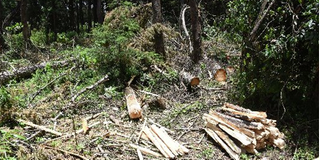Tree with the most expensive wood globally

Illegal logging in a forest in Elgeiyo Marakwet. The high demand of mpingo’s products has left the tree facing extinction because of over-harvesting and its low germination and slow growth rates. PHOTO | FILE | NATION MEDIA GROUP
What you need to know:
- Mpingo produces the world’s most expensive wood. Heavy and hard as iron, it behaves more like metal than wood.
- Traditionally, its wood has been used for making hoes, construction and fencing poles, fuel, charcoal, pestles, combs, cups and knife handles.
- The high demand of mpingo’s products has left the tree facing extinction because of overharvesting and its low germination and slow growth rates.
- Studies show that there could be up to 600,000 mature trees in Tanzania, yet up to 30,000 are harvested annually.
Dalbergia melanoxylon is native to dry regions of Africa; from Senegal in the west to Eritrea in the east and South Africa.
Its common English names include African ebony and African blackwood. In Kiswahili, it is known as Mpingo.
In Kenya, according to Kefri’s A Guide to Tree Planting in Kenya, it grows in zones where the altitude ranges from 0-1,400 metres above sea level and with annual rains of between 800mm and 1,400mm.
Benefits
Mpingo produces the world’s most expensive wood. Heavy and hard as iron, it behaves more like metal than wood.
Sawn logs sell for about Sh900,000 per cubic metre while processed timber fetches up to Sh1.3 million per cubic metre.
Because of its high density, its fine texture and water and fire-repellent characteristics, it is ideal for the production of musical instruments such as clarinets, oboes, flutes, recorders and pipes. It is also used for piano keys and the fret boards of guitars.
It is in high demand in Europe’s big factories that make these instruments.
Furniture makers value this timber because of the durability of its products.
Traditionally, its wood has been used for making hoes, construction and fencing poles, fuel, charcoal, pestles, combs, cups and knife handles.
Medicine
Mpingo is well-known in Africa as a medicinal tree. Nearly all its parts – bark, wood, leaves and roots – are used as medicine.
Scientific studies have confirmed the tree’s medicinal value. One study by Mutai, P. et al in 2013 found that some of Mpingo’s medical uses are:
Roots: Used in treatment of coughs, abdominal pain, hernia and gonorrhea. Also used as an anthelmintic (for intestinal parasites). Smoke of the burning root is used for headache, rhinitis and bronchitis treatment.
Leaves: Used for throat inflammation, syphilis, gonorrhea and dysentery treatment.
They can also be mixed into goat soup that treats backache and joint pain. The heartwood is used in combination with lotion or oil to treat skin diseases.
Bark: For centuries, the Venda people of South Africa have used the bark as an anti-bacterial.
In 1993, the Journal of Ethno-pharmacology reported on scientific tests carried out at the Department of Pharmacy at the University of Zimbabwe verifying this use.
It determined the existence of anti-microbial activity relating to use of the bark of mpingo.
Extinction threats
The high demand of mpingo’s products has left the tree facing extinction because of over-harvesting and its low germination and slow growth rates.
The World Conservation Monitoring Centre, a UNEP conservation project, has mpingo on its red list of endangered species.
In Kenya, mpingo is commercially extinct, meaning it is no longer available in viable quantities.
The wood used in the carving industry is mostly smuggled in from Tanzania and Mozambique and there are concerns about its survival in these countries too.
Studies show that there could be up to 600,000 mature trees in Tanzania, yet up to 30,000 are harvested annually.
At this rate, the tree could be extinct in about 20 years. Tanzanian authorities have started campaigns to get people to plant and conserve this tree.
One big challenge has been that whereas this tree fetches high prices in the international market, the people in its ecological zones get peanuts.
Ensuring that they receive a fair share of the revenue created will give them an incentive to conserve it.
Propagation
Mpingo propagation is mainly through seeds. At Kefri, they cost Sh1,000 a kilogramme.
But Ezekiel Kyallo, an environmental technologist at Kefri, who has been involved in mpingo propagation for many years, says the big challenge is that the germination rate is low.
In addition, seeds stored for more than a year lose their viability.
Once seeds germinate, they take up to seven months before they are transplanted in the field.
Kefri produces an average of 30,000 seedlings a year many of which are planted in public forested areas. However, their survival rate is not known.
On average, these trees mature in about 30 years but others can take up to 60 years.
Intensive care is recommended when they are still young because they do not compete well with weeds.
It is thus recommended to mix them with some faster-growing species as long as they do not create too heavy a shade.
Mr Wanyonyi is Managing Partner at Storylines Kenya, [email protected]




